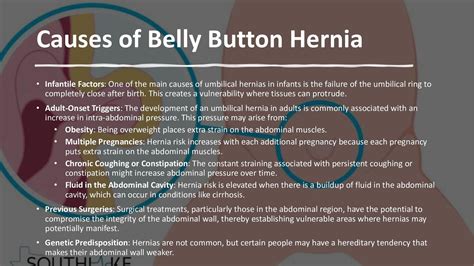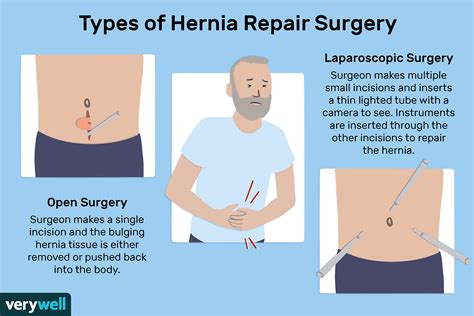The belly button, or navel, is a natural indentation in the abdominal wall where the umbilical cord was once attached during fetal development. However, for some individuals, this area can be prone to a type of hernia known as an umbilical hernia or belly button hernia. This condition occurs when part of the intestine or other abdominal tissue bulges through a weakened area in the abdominal wall near the navel, resulting in a noticeable bulge or protrusion.
Understanding the Causes
Several factors can contribute to the development of a belly button hernia. One of the primary causes is a weakening of the abdominal wall, which can be due to various reasons:
- Genetics: Some people may be born with a natural weakness in the abdominal wall, making them more susceptible to developing an umbilical hernia.
- Age: Infants and young children are more prone to umbilical hernias due to their underdeveloped abdominal muscles. However, adults can also develop this condition, especially if they have a family history or have experienced significant weight gain or loss.
- Obesity: Excess weight can put additional strain on the abdominal wall, increasing the risk of a hernia.
- Pregnancy: The increased pressure on the abdominal wall during pregnancy can cause or exacerbate an existing umbilical hernia.
- Chronic coughing or straining: Prolonged coughing or straining during bowel movements can weaken the abdominal muscles and contribute to the development of a hernia.
- Previous abdominal surgery: Individuals who have undergone abdominal surgery may be at a higher risk of developing an umbilical hernia, especially if the surgical site is near the navel.
- Congenital conditions: Certain congenital conditions, such as Down syndrome or Ehlers-Danlos syndrome, can increase the risk of developing an umbilical hernia.
Symptoms and Diagnosis
The symptoms of a belly button hernia can vary depending on the individual and the severity of the condition. Common symptoms include:
- A noticeable bulge or protrusion near the navel
- Discomfort or pain in the abdominal area, especially when coughing, straining, or lifting heavy objects
- A feeling of heaviness or pressure in the abdominal area
- In severe cases, nausea, vomiting, or constipation may occur
To diagnose an umbilical hernia, a healthcare professional will typically perform a physical examination and take a medical history. They may also order imaging tests, such as an ultrasound or CT scan, to confirm the diagnosis and rule out other potential causes of the symptoms.
Repair Surgery Guide
In some cases, a belly button hernia may not require surgical intervention, especially if it is small and not causing significant symptoms. However, if the hernia is large, painful, or causing complications, surgery may be necessary to repair the weakened area in the abdominal wall.
There are several surgical approaches to repairing an umbilical hernia, including:
- Open hernia repair: This traditional surgical approach involves making an incision near the navel to access the hernia and repair the weakened area.
- Laparoscopic hernia repair: This minimally invasive approach uses small incisions and a laparoscope (a thin, lighted tube with a camera) to visualize the hernia and repair the weakened area.
- Robotic hernia repair: This advanced surgical approach uses a robotic system to assist the surgeon in repairing the hernia through small incisions.
The surgical procedure typically involves the following steps:
- Preparation: The patient is given general anesthesia and prepared for surgery.
- Incision: The surgeon makes an incision near the navel, either open or laparoscopic.
- Hernia repair: The surgeon repairs the weakened area in the abdominal wall using sutures or mesh.
- Closure: The incision is closed, and the patient is taken to the recovery room.
Postoperative Care and Recovery
After surgery, it is essential to follow the surgeon’s instructions for postoperative care and recovery. This may include:
- Resting and avoiding heavy lifting or strenuous activities for several weeks
- Taking pain medication as prescribed
- Attending follow-up appointments to monitor the healing process
- Avoiding heavy lifting or bending for several months
By understanding the causes, symptoms, and treatment options for belly button hernias, individuals can take proactive steps to prevent and manage this condition. If you are experiencing symptoms of a belly button hernia, it is essential to consult with a healthcare professional for proper diagnosis and treatment.
What are the risks of not treating a belly button hernia?
+If left untreated, a belly button hernia can lead to complications such as incarceration, where the hernia becomes trapped and cannot be pushed back into the abdomen, or strangulation, where the hernia cuts off blood supply to the affected tissue.
Can a belly button hernia be prevented?
+While some risk factors for belly button hernias cannot be controlled, maintaining a healthy weight, avoiding heavy lifting, and managing chronic coughing or straining can help reduce the risk of developing this condition.
How long does it take to recover from belly button hernia surgery?
+The recovery time for belly button hernia surgery can vary depending on the individual and the surgical approach. Generally, most people can return to their normal activities within 4-6 weeks after surgery, but it may take several months for the abdominal muscles to fully heal.



